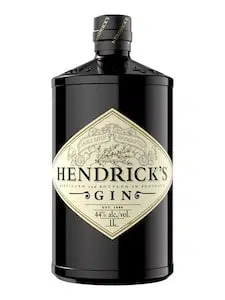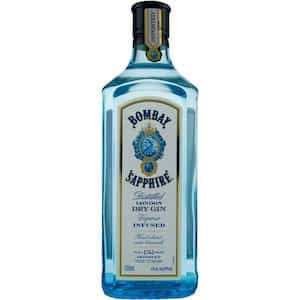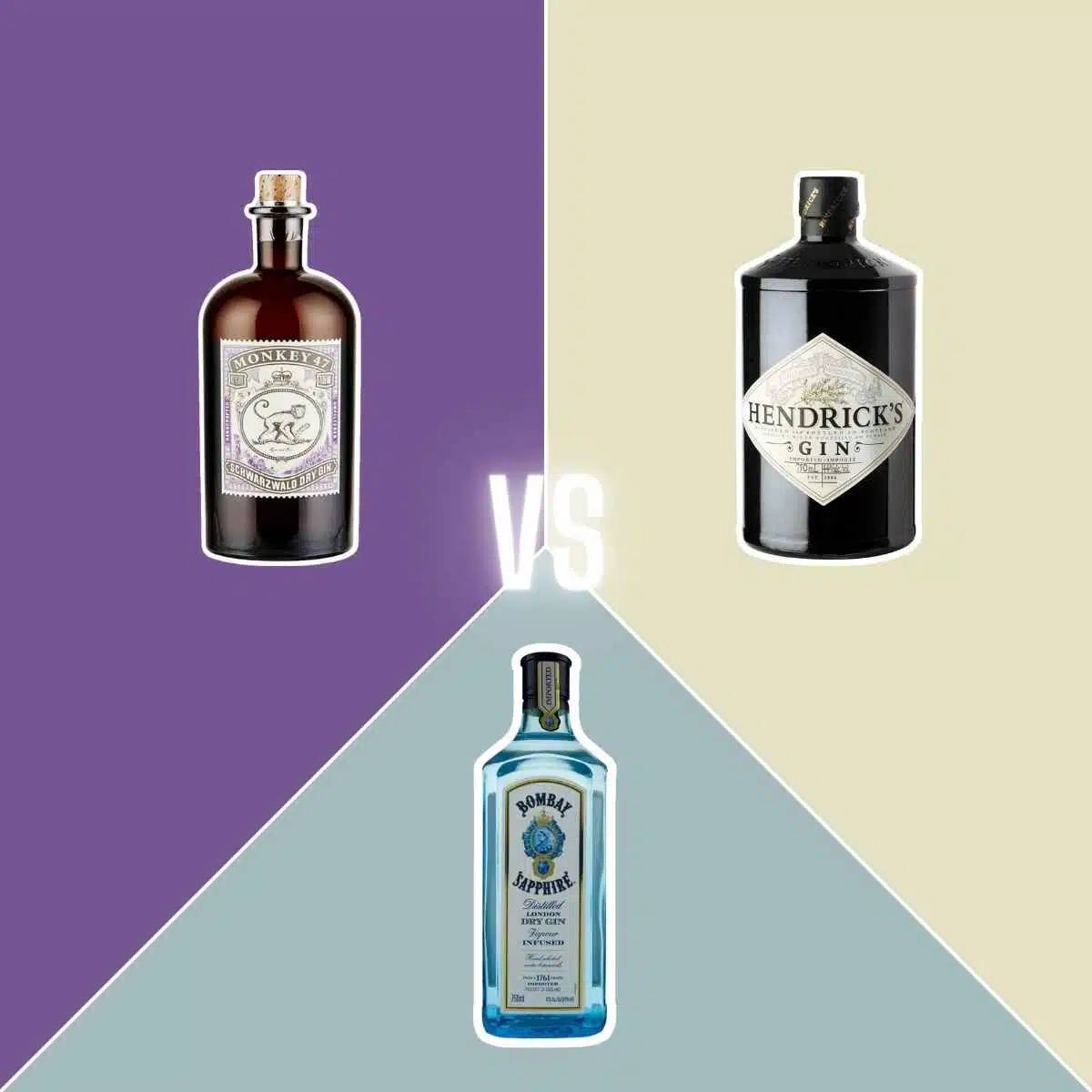The demand for gin has been on a sharp incline for years, and there's no end in sight. At the same time, looking at the worldwide gin market, thousands of brands compete for discerned gin drinkers.
The three bottles were looking at in this article are all of outstanding quality, are consumer favorites, and hence some of the best gins you can get right now. Yet, you still might ask yourself - Why these 3? The answer is pretty straightforward.
They have so much in common, and all three brands have made it their mission to stand out from the mass market of juniper-forward London Dry Gins. Another aspect that unites the three brands is an excellent marketing department that knows how to put its product in the limelight.
Let's dive into this comparison of Monkey 47 vs Hendrick's vs Bombay Sapphire Gin and start with an overview to highlight their distinct features.
Comparison Table
| Monkey 47 Dry Gin | Hendrick's Gin | Bombay Sapphire | |
|---|---|---|---|
| ABV | 47% | 44% (US) 41.4% (UK) | 40% (47% in the US) |
| Proof | 94 | 88 | 80 (94 in US) |
| Country | Germany | Scotland | England |
| Price | $60 | $35 | $15 - $20 |
| # of Botanicals | 47 | 13 | 10 |
| Dominant flavors | Juniper, mint, lemon balm, spruce, rosemary | Juniper, coriander, angelica, and citrus | Juniper, herbs, citrus, and floral notes |
| Introduced | 2010 | 1999 | 1986 |
| Owned by | Pernod Ricard | William Grant & Sons | Bacardi |
Monkey 47 Dry Gin

- ABV: 47%
- Distilled at: "Zum Wilden Affen" Distillery in Black Forest, Germany
- Price Band: $60
- Taste: Juniper, mint, lemon balm, spruce, rosemary
History & origin
Monkey 47 Schwarzwald Dry Gin is a renowned Gin brand produced in the Black Forest region of Germany since 2010. Its delicious and complex flavor profile has made it a tremendously popular choice among Gin connoisseurs worldwide.
Moreover, its unique production process, which utilizes 47 different botanicals, adds to its allure. Consequently, Monkey 47 has firmly established itself as a quality option for those seeking a unique and flavorful gin experience.
How does Monkey 47 Gin compare? Monkey 47 Dry Gin is a fantastic contemporary Gin with a huge array of flavors and aromas. It tastes excellent when drank neat and mixes nicely in cocktails, adding a unique and distinct touch. For lovers of classic Gins, it might lack intense juniper notes.
Taste
The flavor profile of Monkey 47 is extremely complex. Even though you can't taste each of the 47 botanicals individually, you can smell and taste immediately how many different flavors of spices and herbs go into this Gin.
- Nose: The nose is slightly junipery with minty notes and floral aromas like lavender, rose, and hibiscus. There are also many herbal notes like lemon verbena and sage, complemented by a citric lime aroma.
- Palate: On the palate, you get plenty of minty and herbal flavors paired with juniper, spruce, and rosemary. The more often you sip, the more flavors and botanicals you can detect.
- Finish: The finish is dominated by more minty notes and herbal flavors like lemon verbena and bee balm. In the background, you get peppery notes and hints of berries.
Botanicals & Production process
Most brands try to keep their ingredients and recipes secret. However, for Monkey 47, most botanicals are known and even published on their website.
Here's the full list of botanicals in the recipe: Acacia flower, allspice, Angelica, bitter orange, blossoms of Monarda didyma, bramble leaves, chamomille, cardamom, cassia bark, cloves, coriander, cubeb pepper, grains of paradise, grapefruit peels, hawthorn berries, jasmine, licorice, lemon balm, lemon peels, lingonberry, musk seed, nutmeg, orris root, rose hip peel, sage, spruce shoots, verbena, wild honeysuckle.
Use in cocktails
Monkey 47 is one of my favorite Gins to use in cocktails if I want to increase the complexity of a drink. It's amazing how, just by changing the Gin base, you can alter the taste of classics like a Gimlet, Gin Sour, or Martini.
My favorite drinks to use it for are a Gin Fizz, Negroni, and G&T. In a Gin Fizz, Monkey 47 turns out refreshingly fruity, and in a Negroni, you'll also get some fruity hints but also a lot more herbal and spicy flavors.
In a Gin Tonic, I prefer to pair it with a Fever-Tree Indian tonic water and garnish it with a lemon slice, dried juniper berries, and optional rosemary or spruce. That helps to unfold the various flavors of the Gin and makes the drink even better.
Hendrick's Gin

- ABV: 44%
- Distilled at: Girvan distillery in Ayrshire, Scotland
- Price Band: $35
- Taste: Juniper, coriander, angelica, and citrus
History & origin
At a time when Gin wasn't as diverse and successful as it is today, William Grant & Sons launched Hendrick's Gin, which has since become a key contributor to the resurgence of Gin's popularity. Consequently, this has helped to create the diverse and thriving Gin category we see today.
Not only has the company excelled in its own unique offerings, but its creativity and experimentation have also provided a platform for further exploration by other distillers and mixologists. As such, Hendrick's legacy is an integral part of today's gin-drinking experience.
How does Hendrick's Gin compare? When Hendrick's Gin was launched in 1999, its flavor profile was incredibly modern and avant-garde. Yet, compared to younger brands like Monkey 47, the flavors in Hendrick's remain more classic. There's still a distinct and dominant juniper note, complemented by the other botanicals.
Taste
Tastewise, Hendrick is a perfect all-rounder. It has distinct juniper notes but is not as dominant on the juniper notes as Tanqueray or Beefeater. Instead, it does an excellent job of marrying traditional flavors like coriander, angelica, and juniper with more unique flavors like rose petals, cucumber, and earl grey tea.
- Nose: Dominant juniper aroma complemented with floral notes from rose petals and elderflower and citric notes from lime and oranges.
- Palate: On the palate, Hendrick's shows everything a classic Gin needs. A decent amount of juniper mixed with flavors from traditional botanicals like angelica, coriander, and citrus.
- Finish: Quite a warm and long finish with plenty of juniper notes, complemented by rose petals, hints of cucumber, and a touch of early grey tea.
Botanicals & Production process
Hendrick's Gin is made in two batches. One utilizes the Carter Brothers' signature "Gin basket" in which botanicals are placed in a copper basket where the vapor passes through them.
The second batch uses a traditional pot still method, macerating all ingredients, except rose and cucumber, for 24 hours before distillation. The two distillates are blended before the rose and cucumber essences are added to the mix, creating the unique flavor profile that makes Hendrick's Gin stand out.
The botanicals in Hendrick's besides rose and cucumber are angelica root, caraway, chamomile, coriander, cubeb pepper, elderflower, juniper, lemon, orange, orris, and yarrow root.
Use in cocktails
A well-made Gin and Tonic made with Hendrick's Gin and garnished with fresh cucumber are still one of the best ways to experience this Gin. The subtle notes of cucumber and rose in this drink make it easily one of the best ways to make this drink.
Hendrick's also works in many other Gin cocktails as the backbone of the spirit is quite traditional, making it super versatile. However, mixed with other flavorful ingredients, Hendrick's loses its signature taste. You won't be able to detect any rose or cucumber notes in a Negroni cocktail or a Gin Sour.
Bombay Sapphire Gin

- ABV: 47%
- Distilled at: Laverstoke Mill in Laverstoke, England
- Price Band: $15 - $20
- Taste: Juniper, floral, citrus, herbs
History & origin
Founded in 1986, Bombay Sapphire is known for its striking blue bottle design. The brand is owned by Bacardi and produces its Gin at Laverstoke Mill, where they also built a huge visitor center for people who want to visit the distillery.
Their Sapphire Gin is unique and complex, featuring ten different botanicals that create an aromatic and flavorful experience. The nose is spicy and citric, whereas the palate shows a unique mix of earthy, floral, and spicy flavors with hints of juniper berries.
How does Bombay Sapphire Gin compare? Bombay Sapphire has a beautifully balanced flavor profile. It's less junipery than most other classic London Dry Gins and impresses with its floral and citrus notes instead.
Taste
The flavor profile offers a nice combination of juniper, lemon, and coriander. None is overpowering, and all go together beautifully.
- Nose: The nose of Bombay is very citric with hints of juniper in the background.
- Palate: On the palate, the Gin offers a gentle heat and an interesting mix of spicy, earthy, and floral flavors that are complemented by distinct notes of juniper and citrus.
- Finish: The finish once again shows an interplay of lemon, juniper, and coriander.
Botanicals & Production process
Bombay Sapphire Gin incorporates ten different botanicals to create its iconic flavor. Instead of steeping these botanicals in neutral grain spirit, Bombay Sapphire uses a unique technique called "vapor infusion extraction" to infuse the botanicals with flavor.
This method allows for a more complex and nuanced flavor profile, providing an incredibly smooth and delicious gin. For this, the botanicals are placed in a basket, and as the alcohol evaporates, it passes these baskets, thus infusing the liquid with the flavors before it turns liquid again.
The botanical ingredients going into Bombay Sapphire are almonds, angelica root, cassia bark, coriander, cubeb pepper, grains of paradise, juniper, lemon peels, licorice, and orris root.
Use in cocktails
Due to its balanced flavor profile with prominent yet not overpowering juniper notes, Bombay is an excellent choice for a wide range of classic Gin-based drink recipes. We recommend using it in a Dry Martini, Gin Gin Mule, and Classic Gin and Tonic garnished with a lemon wedge or lemon peel.
It doesn't influence the taste of these drinks in a significant way but mixes perfectly well with other ingredients to make an excellent drink.
Conclusion
Monkey 47, Hendrick's, and Bombay Sapphire are all great Gins. Which one is best will depend on your tastebuds, your budget, and what you want to do.
If you're looking for a truly unique Gin that will improve the flavors of cocktails, Monkey 47 is our favorite. It comes at a steep price point, especially compared to the other two options, but it's great in cocktails or neat.
If you're looking for an excellent Gin in a Gin Tonic but don't want to spend top-shelf dollars, Hendrick's Gin is the best choice. The hint of roses and cucumbers is subtle yet distinct - a perfect match with chilled tonic water and a slice of fresh cucumber.
Bombay Sapphire also does the job in a G&T and is extremely versatile in cocktails. The flavor profile is well-balanced but not as distinct. If you consider the price, you get a lot of performance for little money with the Bombay Sapphire. A good addition to any home bar.
Which one are you choosing: Monkey 47 or Hendrick's or Bombay Sapphire? Let us know in the comments!
More gins to discover
- Botanist Islay Dry Gin - This Gin from the Isle of Skye in Scotland features a vast amount of local ingredients.
- Roku Gin - This Japanese gin produced by Suntory is flavored with distinct botanicals that represent the different seasons in Japan.
- Plymouth Gin - The only gin at the moment that is both, a brand and a separate sub-type of gin.

